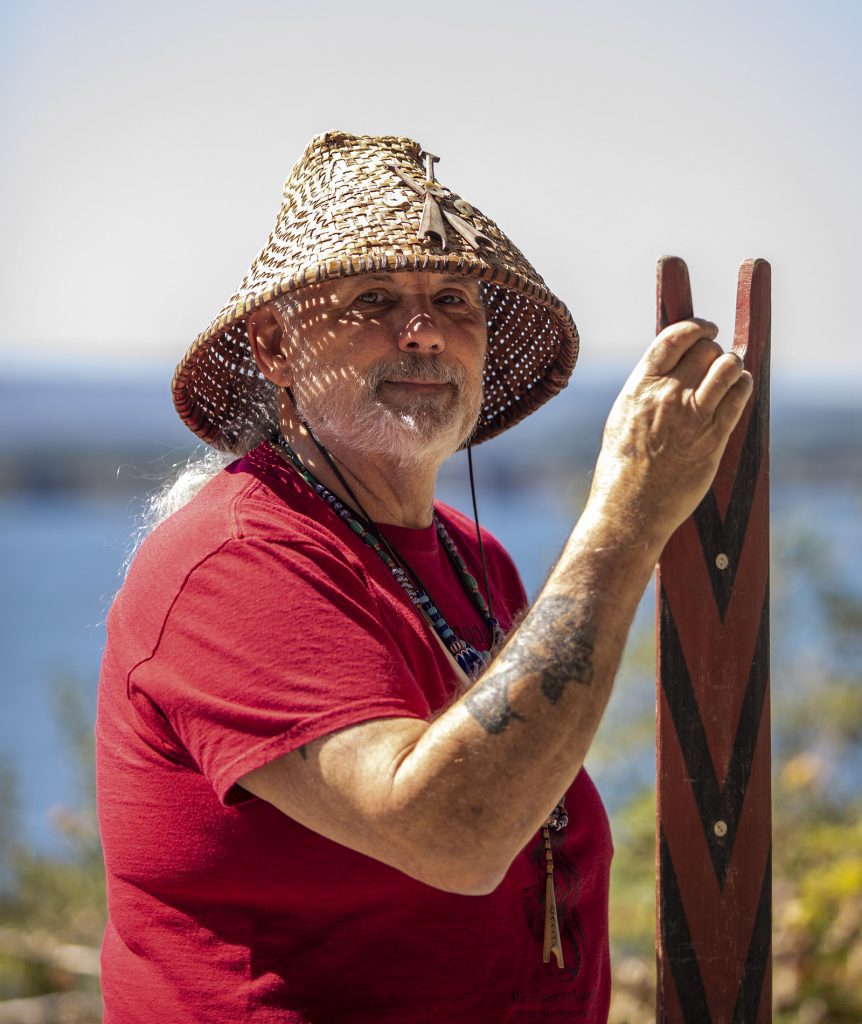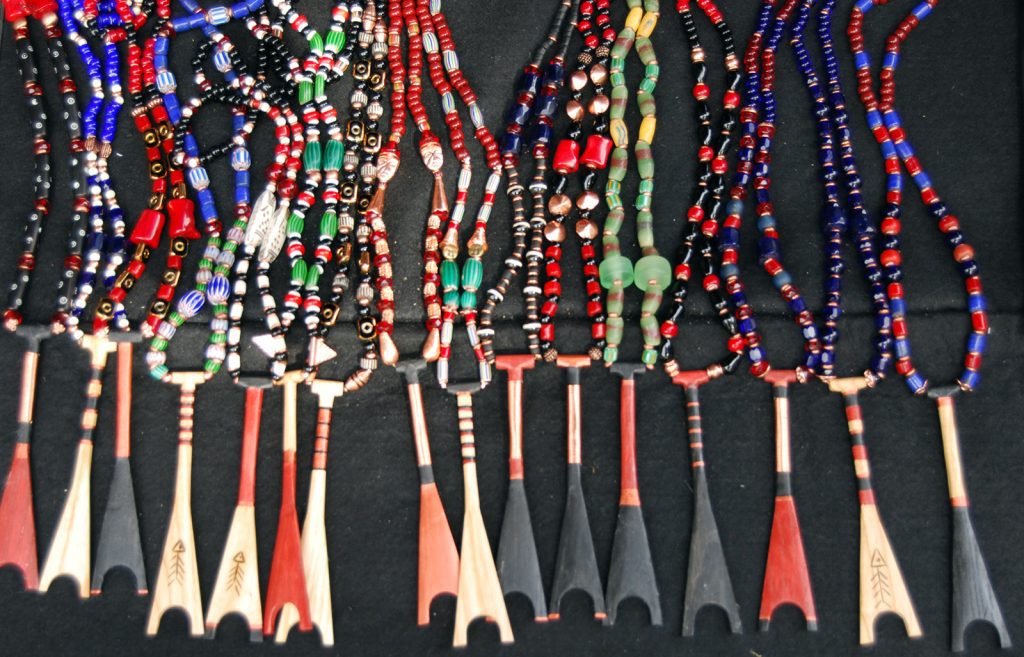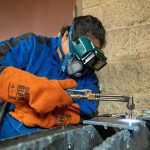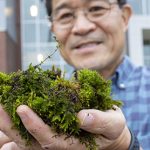Headwaters of leadership
Sam Robinson ’83 learned lessons at Clark that help him lead the Chinook Indian Nation today
Clark does more than launch new careers. In Sam Robinson’s case, Clark helped prepare him for a different kind of purpose.
4-minute read
Robinson ’83 was elected in June 2022 to his eighth term on tribal council as vice chairman of the Chinook Indian Nation. Chinook Indian Nation is made up of five tribes that live near the mouth of the Columbia River—the Clatsop and Cathlamet of present-day Oregon and the Lower Chinook, Wahkiakum and Willapa of present-day Washington. They are distinct tribes that share a spoken language, Chinookan, and many cultural practices especially those focused on the river.

Clark College helped prepare Sam Robinson ’83 for tribal leadership. As vice chairman of the Chinook Indian Nation, he advocates for his tribe and serves as a cultural ambassador.
Robinson said during a recent interview that his experiences at Clark helped prepare him for tribal leadership.
Robinson’s paternal great-great- great-grandfather was Thomas Huckswelt, chief of the Willapa, who signed a treaty with Commissioner of Indian Affairs Anson Dart in 1851. In that treaty, the tribes sold land to the United States government for 3 cents per acre and the U.S. created a reservation for the tribes within their traditional homelands. The treaty was never ratified by the U.S. Congress, however, because it failed to remove the Native Americans from the area—one of the major goals for sending Dart to the Oregon territories in the first place. The Chinookan people declined to sign later treaties that would have had them move to remote reservations.
“We stayed with the bones of our ancestors,” Robinson said.
Evolution of a leader
Robinson was born in South Bend, Wash., but moved with his family when he was 1 year old to La Center, Wash., so his father could help his father start a business, Robinson Cold Storage. The family regularly traveled to Bay Center, Wash., to visit relatives. Robinson remembers pulling into town in the spring and fall, especially, and smelling the fish being smoked. He remembers waiting for what felt like hours and hours until the fish was ready. A relative would open the smokehouse door and dole out tender pieces of smoked salmon.
Robinson enlisted in the military at age 17 but deferred his service. He then joined the Army in 1975, just as the Vietnam war was ending. He left the military in 1979 without seeing combat.
Following his veteran service and while re- acclimating to civilian life, Robinson decided he wanted to see what the tribe was up to. He lived in Vancouver, Wash., but drove to Chinook to the old Chinook school, for a meeting. Off-duty sheriff ’s deputies stood outside the doors. Inside, people yelled at each other about a tribal-owned bingo parlor that had once earned decent money but was being mismanaged and shut down. Emotions ran high. Robinson’s cousin, Midge, screamed at people. His uncle got kicked out.
Later, Midge told him. “Sam, you need to get on council.” Robinson laughed at this statement at the time.
But he kept showing up to meetings, even if just to listen. He reconnected with relatives and watched as the Chinook Tribal Council eventually mellowed out.
Camaraderie at Clark
Around the same time, Robinson enrolled at Clark College to make use of the GI benefits he earned from serving in the Army. He worked during the day at the Calvert Company Glulam factory and attended Clark at night.
“Clark did help me in my preparation, moving toward tribal leadership,” he said.
He appreciated that he was studying alongside people of all ages and walks of life. And Clark gave him some of the camaraderie that he’d missed since leaving the Army.
Robinson said his time at Clark reinforced the wisdom of listening before speaking. He watched as some fellow students talked incessantly during class, shouting out what he considered to be ill- considered questions. He watched and listened, and he thought about what kind of tribal leader he wanted to be someday.
Taking night classes at Clark also taught him how to balance work with other obligations so that when he was ready to serve on tribal council, it didn’t interfere with his livelihood. Robinson has worked for Calvert Company Glulam for 43 years, holding several different jobs including safety director. He said the company has been unwavering in supporting his tribal leadership service.
Sometime around 2001, a member of the tribal council fell ill and Robinson applied—along with a handful of others—to fill the seat. Robinson was selected. Six months later, he ran for a full three-year term. He has served on the council ever since.
Chinookan advocate
As vice chairman, Robinson advocates for the Chinookan people, who are not officially recognized by the U.S. government. Recognition is a legal term meaning that the U.S. recognizes the tribal government as its own type of nation. Federally recognized tribes possess certain powers of self-government and are entitled to specific benefits, services and protections.

Ilchee, or Moon Woman, was the daughter of Chinook Chief Comcomly and was integral to the prosperity of Vancouver in the 1800s. The seven foot, 700-pound bronze figure is located along the Columbia River in Vancouver, Wash. Photo by Jenny Shadley
The result of this legal distinction, according to Robinson, is that Native American tribes are divided into haves and have nots. The Chinook Indian Nation doesn’t have special hunting and fishing rights like federally recognized tribes do, for example. They don’t receive healthcare and housing assistance. Most importantly to Robinson, they don’t have the right to protect the bones of those ancestors they refused to leave during treaty negotiations.
In 2001, the U.S. recognized the Chinook Indian Nation only to rescind that recognition 18 months later, following an appeal by another tribe.
To Robinson, recognition matters. He has traveled to Washington, D.C., to meet with officials and try to convince them to reinstate recognition for the Chinook Indian Nation. In August 2022, Robinson helped lead a rally in Seattle to gain support of the tribe’s need for national recognition.
But with or without recognition, the Chinookan people are still here.
Ambassador
One of Robinson’s responsibilities as vice chairman is to serve as an ambassador for the Chinook Indian Nation. He frequently represents the Chinook Indian Nation at public events.
“It’s always good when someone’s interested in the tribe,” he said.
He has returned to Clark College several times, giving talks or blessings for public events. He has also taught classes in community and continuing education, formerly known as mature learning, at Clark.
Clark may have taught him the lesson of listening, but Robinson is a naturally enthusiastic talker. He’s passionate about the Chinook canoe traditions and he crafts traditional wood canoe paddles.
He is fluent in Chinookan and he sprinkles Chinookan words into his speech.
Chinookan history stretches back more than 10,000 years. Archaeologists have found evidence of people living in this region more than 12,000 years before the present era. Prior to European contact, the Pacific Northwest coast was one of the most populous parts of North America, with tens of thousands of people living on Chinook lands.
Traditional wooden canoes
The Columbia River was the lifeblood of Chinookan people. Chinook canoes were created by hollowing out a single log, usually western red cedar. The canoes featured a raised prow, often decorated with carved figures. One canoe measured up to 50 feet long and could carry seven tons of cargo. The Columbia River was a major trade route back then as it is now, and the massive canoes were precursors to the heavy shipping barges that float up and down the river today.

In his spare time, Chinook vice chairman Sam Robinson ’83 makes canoe paddles, using a design unique to Chinook people, as well as tiny versions of the paddles for jewelry.
When white settlers—whom Chinookan people called “Bostons”—arrived in the area, they were impressed with Chinookan people’s trading savvy.
Explorers Meriweather Lewis and William Clark were impressed with the Chinookan people’s canoe-making skills and their unparalleled ability to navigate the canoes under treacherous conditions. While weathering a storm near the mouth of the Columbia in November 1805, Clark made note of a group of Chinookans paddling a canoe, packed with salmon to trade on the coast, through what he described as “the highest Sees I ever Saw a Small vestle ride.” The Chinookans paddled casually, stopping briefly to speak with the stranded explorers before continuing on their way. Clark wrote that they were “Certainly the best Canoe navigators I ever Saw.”
Robinson is the proud keeper of a Chinook style canoe named “Ixt•xut,” which means “the bear.” It was made by a historic re-enactor to commemorate the 200th anniversary of the Lewis and Clark expedition.
At 66, Robinson considers himself a tribal “elder in training.”
“I’m not an elder, I don’t have that much knowledge,” he said with a laugh. Luckily for Robinson—and the Chinook Indian Nation—he doesn’t plan to stop learning.
 Lily Raff McCaulou’s writing has appeared in The New York Times, The Atlantic, The Guardian and Rolling Stone. Visit her online.
Lily Raff McCaulou’s writing has appeared in The New York Times, The Atlantic, The Guardian and Rolling Stone. Visit her online.



